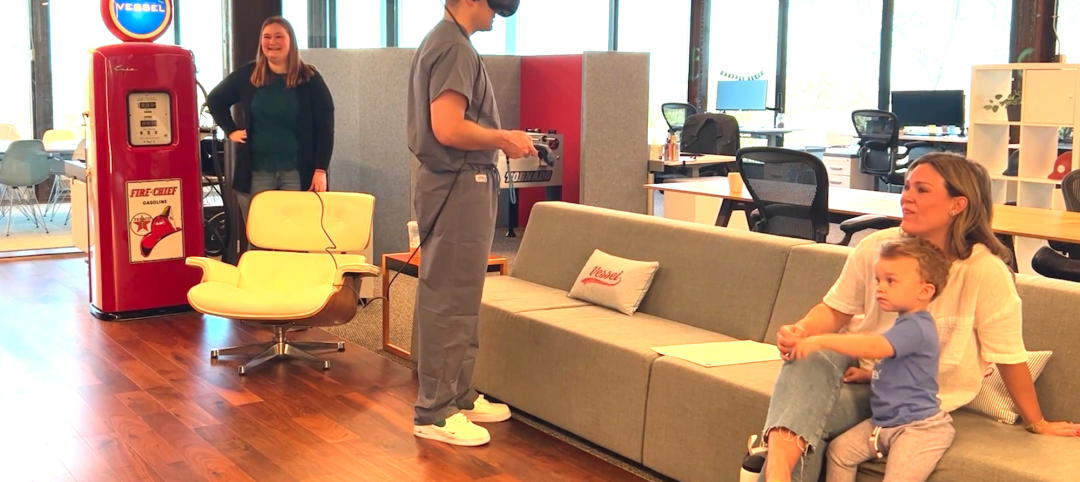Last month, I wrote about how automation and AI are dramatically changing all four fundamental relationships between buildings and machines. For example, nanotechnology, which manipulates individual atoms and molecules to assemble things, could make the modernist metaphor of a “machine for living in” into reality, since the building would actually be composed of many tiny machines.
In fact, that’s not quite accurate. The definition of “machine” is “an apparatus using or applying mechanical power and having several parts, each with a definite function and together performing a particular task.”
So machines are made of distinct parts, cobbled together to fulfill a function. They are characterized by their composition, as assemblages of singular bits and pieces in which the whole is greater than the sum.
SEE ALSO: Assessing AI's impact on the AEC profession and the built environment
But nanotech will completely change this. When entire buildings can be shaped from microscopic components, the visible distinction between the individual parts will evaporate. A structure built from invisible machines will not appear to be a machine at all, since it no longer will be perceived as an assembly of parts. An edifice made of congealed cybernetic butter will look to be all whole, no parts. The very concept of a “building” could become meaningless, since it will no longer be “built” in any traditional way.
Remember “Terminator 2”? Arnold Schwarzenegger’s T-800 is a machine: steel and servos wrapped in human skin. Robert Patrick’s T-1000 is made of liquid metal (“mimetic polyalloy”). He’s like sentient mercury, morphing into any shape he needs. A nanotech building (“nanotecture”?) would make conventional structures seem like Robby the Robot (of “Forbidden Planet” fame).
Buttery buildings could change everything we think and know about architecture. Frank Lloyd Wright felt that architectural form should stem from the inherent “nature” of its materials: “Each material speaks a language of its own.” In his mind, the proportions, heft, and texture of brick logically translated into structures such as the Robie House, which extends horizontally and hugs the land. But when the constituent parts of a building are too small to be seen with the naked eye, the relationships between form and materials will change. What is the “language” of a nanobot?
Because the character of a building could vary upon command—hard and opaque one minute, soft and transparent the next—the fabric of buildings could become fluid, fluctuating states from solid to liquid to gas and back. The notion of truth in materials will become irrelevant. In fact, the word material could go away. When the basic building blocks of architecture have no strict definition, structure and substance could separate. Matter may not matter.
Could there come a time when buildings will become less about bricks and mortar and feel more like mists or fogs, vaguely enveloping space in ways we can barely picture now? What will it be like to live in a cloud?
Lance Hosey, FAIA, LEED Fellow, is a Design Director with Gensler. His book, The Shape of Green: Aesthetics, Ecology, and Design, has been an Amazon #1 bestseller in the Sustainability & Green Design category.
Related Stories
Building Owners | Aug 23, 2023
Charles Pankow Foundation releases free project delivery selection tool for building owners, developers, and project teams
Building owners and project teams can use the new Building Owner Assessment Tool (BOAT) to better understand how an owner's decision-making profile impacts outcomes for different project delivery methods.
Transportation & Parking Facilities | Aug 23, 2023
California parking garage features wind-activated moving mural
A massive, colorful, moving mural creatively conceals a newly opened parking garage for a global technology company in Mountain View, Calif.
Digital Twin | Jul 31, 2023
Creating the foundation for a Digital Twin
Aligning the BIM model with the owner’s asset management system is the crucial first step in creating a Digital Twin. By following these guidelines, organizations can harness the power of Digital Twins to optimize facility management, maintenance planning, and decision-making throughout the building’s lifecycle.
Designers | Jul 25, 2023
The latest 'five in focus' healthcare interior design trends
HMC Architects’ Five in Focus blog series explores the latest trends, ideas, and innovations shaping the future of healthcare design.
Digital Twin | Jul 17, 2023
Unlocking the power of digital twins: Maximizing success with OKRs
To effectively capitalize on digital twin technology, owners can align their efforts using objectives and key results (OKRs).
Standards | Jun 26, 2023
New Wi-Fi standard boosts indoor navigation, tracking accuracy in buildings
The recently released Wi-Fi standard, IEEE 802.11az enables more refined and accurate indoor location capabilities. As technology manufacturers incorporate the new standard in various devices, it will enable buildings, including malls, arenas, and stadiums, to provide new wayfinding and tracking features.
Virtual Reality | Jun 16, 2023
Can a VR-enabled AEC Firm transform building projects?
With the aid of virtual reality and 3D visualization technologies, designers, consultants, and their clients can envision a place as though the project were in a later stage.
AEC Innovators | Jun 15, 2023
Rogers-O'Brien Construction pilots wearables to reduce heat-related injuries on jobsites
Rogers-O'Brien Construction (RO) has launched a pilot program utilizing SafeGuard, a safety-as-a-service platform for real-time health and safety risk assessment. Non-invasive wearables connected to SafeGuard continuously monitor personnel to prevent heat exhaustion on jobsites, reducing the risk of related injuries. RO is the first general contractor to pilot this program.
Contractors | May 26, 2023
Enhanced use of data is crucial for improving construction job site safety
Executives with major construction companies say new digital tools are allowing them to use data more effectively to reduce serious safety incidents and improve job site safety.
AEC Tech Innovation | May 12, 2023
Meet Diverge, Hensel Phelps' new ConTech investment company
Thai Nguyen, Director of Innovation with Hensel Phelps, discusses the construction giant's new startup investment platform, Diverge.

















